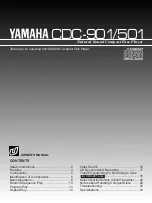
13
EN
29. 8mm Flat Washer
30. 10mm Spacer
31. 6mm Spring Washer
32. M6 x 10mm Nut
33. M8 x 30mm Hex Screw
34. M8 x 20mm Hex Screw
35. 13 x 20mm Bolt
36. M6 x 25mm Hex Screw
37. Outward Stop Bolt
38. Inward Stop Bolt
39. Sliding Stop Block
40. Sliding Protective Plate
41. Blade Screw
42. Blade Clamp
43. Blade Alignment Adjusting Screw
44. Blade
45. Motor Unit Hex Screws
46. Dust Extraction Unit Hex Screws
47. Auxiliary Belt
48. Drive Belt
Intended Use
Mains-powered bench-mounted 152mm surface planer with adjustable fence for planing stock
up to 152mm wide. For light-duty wood planing tasks only.
Unpacking Your Tool
• Carefully unpack and inspect your new tool. Familiarise yourself with all its features and
functions
• Ensure that all parts of the tool are present and in good condition. If any parts are missing
or damaged, have such parts replaced before attempting to use this tool
Before Use
WARNING:
Ensure the tool is disconnected from the power supply before attaching or
changing any accessories, or making any adjustments.
WARNING:
ALWAYS wear suitable cut proof gloves (not supplied) when handling this tool.
Important guidance for the safe use of this tool
• Disconnect the tool from power source whenever adjusting or replacing any parts
• Ensure the ON/OFF Switch is in the ‘OFF’ position before connecting the tool to mains
power
• Keep limbs away from all moving parts
• Wear eye protection and a face mask when using this tool
• Make sure all mobile parts move freely and are free from interference
• Keep Blades sharp, aligned and properly secured to the cutter head
• Never turn the machine ‘ON’ with the workpiece in contact with the Blades
• Whenever the planer/thicknesser is not in use, switch ‘OFF’ and disconnect from power
• Keep the planer/thicknesser in good order. Follow the maintenance instructions (see
‘Maintenance’)
• Never use the planer/thicknesser to make partial cuts - allow it to cut the full length of
the workpiece
• Do not use the planer/thicknesser to cut recesses, tenons or moulds
• Note the rotational direction of the cutter indicated on the tool
Bench mounting
• Using the Bench Mounting Holes, secure the surface planer to a sturdy flat work surface
using bolts, hex nuts and lock washers (not supplied).
Fence installation
Attaching the fence mounting bracket
1. Align the Fence Mounting Bracket (16) with the Fence Bracket Mount (11) and secure in
place using 2 x M8 x 20mm Hex Screws (34) and 6mm Hex Key (23) (Fig. I)
2. Insert the Fence Locking Plate (17) into the Fence Mounting Bracket. Position so that the
two pins are against the bottom edge of the Fence Mounting Bracket
3. Lock the Fence Locking Plate in position using the Sliding Fence Locking Handle (21) and
10mm Spacer (30). (Fig. II)
Assembling the fence & sliding bracket
1. Attach the Fence (15) to the Fence Sliding Bracket (18) using the M6 x 25mm Hex Screws
(36), 6mm Spring Washers (31) and 5mm Hex Key (24) (Fig. III)
2. Slide the Fence and Sliding Bracket onto the dovetails on the Fence Mounting Bracket and
Fence Locking Plate (Fig IV)
3. Slide the Fence Angle Locking Handle (20) through a 10mm Spacer (30) then the Fence
assembly and screw clockwise to tighten (Fig. V)
Note:
Both the Fence Angle Locking Handle (20) and the Sliding Fence Locking Handle
(21) have independent spring adjustment, which means that the handles can be rotated
independently of the bar. This is done by pulling the handles, rotating then releasing. This
feature can be used when the handles cannot be rotated due to part of the surface planer
assembly interfering.
Attaching the blade drum guard
1. Attach the Blade Drum Guard (19) to the Guard Arm (27) using the two M6 x 10mm Nuts
(32) and two 10mm spanners (not supplied) (Fig. VI)
2. Attach the guard assembly to the surface planer via the Guard Mounting Holes (4) using
the two 13 x 20mm Bolts (35), 2 x 8mm Spring Washers (28) and a 13mm spanner (not
supplied) (Fig. VII)
Attaching the carry handles
1. Attach the Handles (26) using the M8 x 30mm Hex Screws (33), 8mm Spring Washers
(28), 8mm Flat Washers (29) and the 6mm Hex Key (23). (Fig. VIII)
Dust extraction
• Adequate dust extraction is essential for a safe workplace; the fine fibres produced from
planing operations can be hazardous to health. Always wear a dust mask when operating
this machine.
• External dust extraction devices can be attached to the surface planer via the Dust
Extraction Port (13)
Table calibration
1. Place a spirit level (not provided) or similar, flat on the Outfeed Table (1) over the Blade
Drum (2) (Image A)
2. Turn the Cutting Depth Adjustment Knob (7) clockwise to raise the Infeed Table (3) (lower
cutting depth), or anti-clockwise to lower the Table (increase cutting depth), aligning the
Infeed Table with the Outfeed Table for a reading of 0mm
Positioning the fence
WARNING:
ALWAYS ensure that the Sliding Protective Plate (40) is covering the Blade
Drum (2) to the rear of the Fence (15) when the Fence protrudes over the Blade Drum while
operating.
1. The Guide Fence (15) angle can be adjusted to accommodate a variety of workpiece
shapes
2. The Fence can be adjusted to angles between 45° inward and 45°outward
3. There are 3 locking positions that use stops 45° inward 45° outward and 90°
4. For precise measurements use a machinist’s square to check the desired angle of the
Fence
Setting fence at 90°
1. Position the Fence assembly on the surface planer and tighten the Sliding Fence Locking
Handle
2. Loosen the Fence Angle Locking Handle (20)
3. Slide the Sliding Stop block into position by lifting the locking knob and sliding the Block
towards the Fence (Fig. IX)
4. Position the Fence so that the Stop Block is in contact with the magnet on the rear of the
Fence
5. Slide the Sliding Protective Plate over the exposed Blade Drum to the rear of the Fence
6. Once in position tighten the Fence Angle Locking Handle
Setting the fence inward 45°
1. Position the Fence assembly on the surface planer and tighten the Sliding Fence Locking
Handle
2. Loosen the Fence Angle Locking Handle (20)
3. Remove the Sliding Stop Block to prevent interference with the fence positioning
4. Tilt the top of the Fence inward until it comes into contact with the Inward Stop Bolts (38)
(Fig. X)
5. Slide the Sliding Protective Plate over the exposed Blade Drum to the rear of the Fence
6. Tighten the Fence Angle Locking Handle to lock the Fence in position
Setting the fence outward 45°
1. Position the Fence assembly on the surface planer and tighten the Sliding Fence Locking
Handle
2. Loosen the Fence Angle Locking Handle (20)
3. Remove the Sliding Stop Block to prevent interference with the fence positioning
350767/850827_Manual.indd 13
13/02/2020 10:09
Summary of Contents for TSPL 152
Page 2: ...2 1 2 3 7 8 6 5 8 4 12 8 13 11 10 9 8 350767 850827_Manual indd 2 13 02 2020 10 09 ...
Page 4: ...4 48 47 46 45 37 38 39 40 41 44 43 42 2 350767 850827_Manual indd 4 13 02 2020 10 09 ...
Page 5: ...5 Image A Image B Image C Image D 350767 850827_Manual indd 5 13 02 2020 10 09 ...
Page 9: ...9 350767 850827_Manual indd 9 13 02 2020 10 09 ...
Page 25: ...25 EN 25 NL 350767 850827_Manual indd 25 13 02 2020 10 09 ...
Page 35: ...35 EN 35 FR 350767 850827_Manual indd 35 13 02 2020 10 09 ...
Page 87: ...87 EN E PT E 87 RU 350767 850827_Manual indd 87 13 02 2020 10 09 ...
Page 120: ...350767 850827_Manual indd 120 13 02 2020 10 10 ...














































